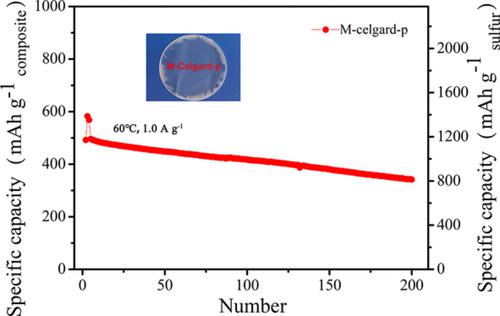当前位置:
X-MOL 学术
›
Int. J. Energy Res.
›
论文详情
Our official English website, www.x-mol.net, welcomes your
feedback! (Note: you will need to create a separate account there.)
A thermo‐stable poly(propylene carbonate)‐based composite separator for lithium‐sulfur batteries under elevated temperatures
International Journal of Energy Research ( IF 4.3 ) Pub Date : 2020-07-08 , DOI: 10.1002/er.5651 Huijia Huang 1 , Changjiang Zhao 1 , Fei Ding 2 , Huan Li 3 , Shuoqing Zhang 1 , Xingjiang Liu 1, 2 , Qiang Xu 1
International Journal of Energy Research ( IF 4.3 ) Pub Date : 2020-07-08 , DOI: 10.1002/er.5651 Huijia Huang 1 , Changjiang Zhao 1 , Fei Ding 2 , Huan Li 3 , Shuoqing Zhang 1 , Xingjiang Liu 1, 2 , Qiang Xu 1
Affiliation

|
Lithium‐sulfur (Li‐S) batteries have a great potential for the future development of energy industry. However, the high‐temperature performance of Li‐S batteries is still facing great challenge due to the high flammability of the electrolyte, sulfur cathode as well as the separator. The separator modification is an effective method to improve the thermal stability of separator and the electrochemical performance of Li‐S batteries under elevated temperatures. However, the reported methods of separator coating are too complicated to be applied in the industrial production. Here, a novel thermo‐stable composite separator (M‐Celgard‐p), in which a layer of silicon dioxide‐poly (propylene carbonate) based electrolyte (nano‐SiO2@PPC) with a high ionic‐conductivity of 1.03 × 10−4 S cm−1 is coated on the commercial Celgard‐p separator, is prepared by using a simple dipping method. Compared to the Li‐S battery assembled with Celgard‐p separator, the M‐Celgard‐p separator combined with a sulfur/polyacrylonitrile (S/PAN) cathode can improve the electrochemical performance of Li‐S batteries, especially their high‐temperature stability. As a result, the (S/PAN)/M‐Celgard‐p/Li cell delivers a high specific capacity of 724.7 mAh g−1 at 1.0 A g−1 after 200 cycles and presents a good rate capability of 1408 mAh g−1 at 1.0 A g−1 and 1216 mAh g−1 at 2.0 A g−1. More importantly, the (S/PAN)/M‐Celgard‐p/Li cell can exhibit a capacity retention ratio of 69.4% after 200 cycles at 60°C. The M‐Celgard‐p separator with high Li‐ion conductivity can not only block the “shuttle‐effect” of polysulfides during cycling but also enhance the thermal stability under elevated temperatures. This work presents a simple dipping method to prepare composite separator with excellent thermal stability, which enhance the rate performance and cyclic stability of Li‐S batteries under elevated temperatures. We believe this work can provide a new way to develop more reliable Li‐S batteries for practical applications.
中文翻译:

高温下用于锂硫电池的热稳定的聚碳酸亚丙酯基复合隔板
锂硫(Li‐S)电池对于能源行业的未来发展具有巨大的潜力。然而,由于电解质,硫阴极和隔膜的高度易燃性,Li-S电池的高温性能仍面临巨大挑战。改进隔膜是提高隔膜在高温下的热稳定性和Li-S电池电化学性能的有效方法。但是,报道的隔板涂覆方法太复杂而不能在工业生产中应用。此处是一种新型的热稳定复合隔板(M-Celgard-p),其中有一层基于二氧化硅-聚碳酸亚丙酯的电解质层(nano-SiO 2 @PPC),具有高离子电导率1.03×10 −4 S厘米-1涂覆在商用Celgard-p分离器上,使用简单的浸渍方法制备。与装有Celgard-p隔膜的Li-S电池相比,M-Celgard-p隔膜与硫/聚丙烯腈(S / PAN)阴极结合可改善Li-S电池的电化学性能,特别是其高温稳定性。其结果是,在(S / PAN)/ M-的Celgard-P / Li电池提供的724.7毫安g的高比容量-1在1.0克-1 200次循环和礼物1408毫安g的良好的倍率性能后- 1在1.0 A g -1下为1216 mAh g -1在2.0 A g -1下。更重要的是,(S / PAN)/ M-Celgard-p / Li电池在60°C下经过200个循环后,容量保持率可达69.4%。具有高锂离子传导性的M-Celgard-p隔膜不仅可以阻止循环过程中多硫化物的“穿梭效应”,而且可以提高高温下的热稳定性。这项工作提出了一种简单的浸渍方法来制备具有优异热稳定性的复合隔膜,从而提高了锂电池在高温下的倍率性能和循环稳定性。我们相信这项工作可以为开发更可靠的Li-S电池以实际应用提供新的方法。
更新日期:2020-07-08
中文翻译:

高温下用于锂硫电池的热稳定的聚碳酸亚丙酯基复合隔板
锂硫(Li‐S)电池对于能源行业的未来发展具有巨大的潜力。然而,由于电解质,硫阴极和隔膜的高度易燃性,Li-S电池的高温性能仍面临巨大挑战。改进隔膜是提高隔膜在高温下的热稳定性和Li-S电池电化学性能的有效方法。但是,报道的隔板涂覆方法太复杂而不能在工业生产中应用。此处是一种新型的热稳定复合隔板(M-Celgard-p),其中有一层基于二氧化硅-聚碳酸亚丙酯的电解质层(nano-SiO 2 @PPC),具有高离子电导率1.03×10 −4 S厘米-1涂覆在商用Celgard-p分离器上,使用简单的浸渍方法制备。与装有Celgard-p隔膜的Li-S电池相比,M-Celgard-p隔膜与硫/聚丙烯腈(S / PAN)阴极结合可改善Li-S电池的电化学性能,特别是其高温稳定性。其结果是,在(S / PAN)/ M-的Celgard-P / Li电池提供的724.7毫安g的高比容量-1在1.0克-1 200次循环和礼物1408毫安g的良好的倍率性能后- 1在1.0 A g -1下为1216 mAh g -1在2.0 A g -1下。更重要的是,(S / PAN)/ M-Celgard-p / Li电池在60°C下经过200个循环后,容量保持率可达69.4%。具有高锂离子传导性的M-Celgard-p隔膜不仅可以阻止循环过程中多硫化物的“穿梭效应”,而且可以提高高温下的热稳定性。这项工作提出了一种简单的浸渍方法来制备具有优异热稳定性的复合隔膜,从而提高了锂电池在高温下的倍率性能和循环稳定性。我们相信这项工作可以为开发更可靠的Li-S电池以实际应用提供新的方法。











































 京公网安备 11010802027423号
京公网安备 11010802027423号